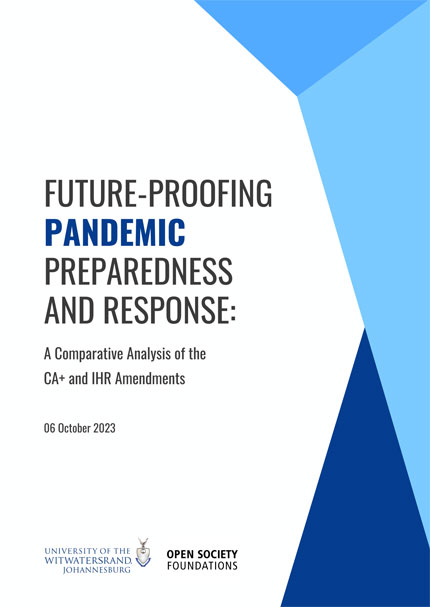Future-proofing pandemic preparedness and response
- Wits University
Comparative analysis of the Pandemic accord and amendments to the International Health Regulations texts.
The COVID-19 pandemic highlighted major shortcomings in the ability of the world to prevent, prepare for, and respond to pandemics. These shortcomings spanned multiple areas, including the surveillance of pathogens of pandemic potential, the effectiveness of International Health Regulations (IHR), and disparities in the supply of vaccines, diagnostics and therapeutics. These issues have led to efforts to reform the governance, regulation and international financing regimes for public health emergencies and pandemics.
 Negotiations relating to the CA+ and the IHR amendments are running concurrently and are due to be concluded by the World Health Assembly in May 2024. There are inevitably overlaps and inconsistencies in scope and content between the two instruments. Furthermore, there are questions relating to what subject matter belongs in each of the two instruments, and a lack of clarity among negotiators as negotiating positions in key contentious areas.
Negotiations relating to the CA+ and the IHR amendments are running concurrently and are due to be concluded by the World Health Assembly in May 2024. There are inevitably overlaps and inconsistencies in scope and content between the two instruments. Furthermore, there are questions relating to what subject matter belongs in each of the two instruments, and a lack of clarity among negotiators as negotiating positions in key contentious areas.
In early 2023, we commissioned a comparative analysis, consultation, and research exercise to clarify issues relating to the inclusion of specific points in one or other instrument, to identify areas of concern and opportunities for consensus. From 3 May 2023 to 5 October 2023, a range of experts and country negotiators were interviewed on their key priorities, concerns and what they believed should be in the IHR versus the Pandemic Accord. These inputs were contextualized with desk review, including scholarship on the character of different legal instruments.
This analysis highlighted that treaties and conventions are designed to be:
- Political signals of priority.
- Facilitators of multilateral cooperation where domestic law and other policy (including other international instruments) have failed.
- Applicable to issues where universal adherence will take time to achieve.
Regulations,[1] on the other hand, pertain to:
- Technical and regulatory matters, and matters related to implementation[2] on a particular issue.
- Nomenclatures on technical terms.
- Standards (for example on safety and purity of pharmaceuticals), or
In addition, the analysis dissects country positions on 9 key areas, including One Health, Pathogen Access and Benefit Sharing, and Common but Differentiated Responsibilities.
For more findings and analysis, read or download the full report: Future-proofing pandemic preparedness and response [PDF].
